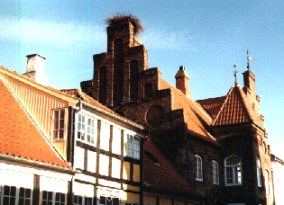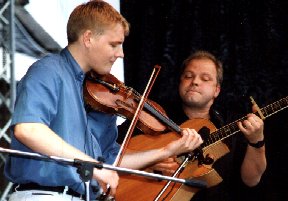FolkWorld article by Michael
Moll:
What is Danish Music?
Scanfolk Part VI: Haugaard & Høirup on the folk mysteries of that small
country
 Officially,
last issue finished the Scanfolk series - but hey there we are with a sixth
part of the series, going back to Denmark, just to find some more out about
the mysteries of folk music and recent developments of this most Southern Scandinavian
country. And the word goes to Morten Alfred Høirup and Harald Haugaard, one
of the best music acts from Denmark, to talk about historical cultural links
of Denmark, folk music education, state sponsoring for folk and more.
Officially,
last issue finished the Scanfolk series - but hey there we are with a sixth
part of the series, going back to Denmark, just to find some more out about
the mysteries of folk music and recent developments of this most Southern Scandinavian
country. And the word goes to Morten Alfred Høirup and Harald Haugaard, one
of the best music acts from Denmark, to talk about historical cultural links
of Denmark, folk music education, state sponsoring for folk and more.
Danish music is somewhat apart from the other Scandinavian folk music tradition,
building a bridge to the south, explains Harald. "Denmark with its 5.5
million inhabitants is a small country placed in the middle of the Northern
part of Europe, traditionally working as a link between the Nordic countries
and the rest of Europe. That means that Denmark through the years has been influenced
by a lot of trends and tendencies when it comes to politics, architecture, theater,
fashions, food and of course music and dance."
"So when we look back through history we see a bunch of different influences
in our music. Influences coming from countries like Germany, England and France.
There was, for example, a great influence of English/Scottish music between
1770 and 1825 and a lot of that music has set its marks on the Danish folk music.
Denmark is nearly surrounded by the ocean and through generations lots of people
have made their living off the sea by fishing or by shipping and trade. It has
always been very easy to bring foreign influences back home, so in a way Denmark
has always been a great Northern-European harbour with lot of traffic of every
kind. At the same time there are certain areas in Denmark with a very special
life of music and dance, places where you will find that the old traditions
are still in use every day. The small western island Fanø probably has the greatest
and the best known musical tradition, a tradition that is still one of the strongest
in Scandinavia. It is from this Island the famous Danish 'Sønderhoning' comes.
Sønderho is the name of the one of the Islands two villages, the southern one."
 Morten
adds that not so many years ago, Fanø was one of the biggest and most important
harbours in Denmark; at certain times there could be up to 200 large sailingships
waiting around the island. "So people from the island went out to strange
countries and places like the Virgin Islands, India and Africa, but also to
the British Isles. They brought much more than beautiful silk and spices back
home, and maybe that is part of what you can hear in the music."
Morten
adds that not so many years ago, Fanø was one of the biggest and most important
harbours in Denmark; at certain times there could be up to 200 large sailingships
waiting around the island. "So people from the island went out to strange
countries and places like the Virgin Islands, India and Africa, but also to
the British Isles. They brought much more than beautiful silk and spices back
home, and maybe that is part of what you can hear in the music."
In Denmark, many people, musicians included, are very fascinated by Fanø-music
and the Danish Folk Music scene is as a whole pretty much flourishing and alive
these days. Morten thinks that the folk music scene has been as thriving since
the great folk revival in the 60´s and 70´s; "suddenly it seems like we
have a small noncommercial revival running." One important development
that influenced the Danish folk revival was, in Morten's opinion, that traditional
Irish and Scottish music came to Denmark (as well as the rest of the world)
some decades ago: "A lot of Danes know much more about Irish music than
of their own tradition. Many people start with Guiness and Irish music -maybe
even with Riverdance - and after a great experience there, they might be a little
more open, positive and curious to go and listen to two Danish fellows playing
at the local venue. Especially, I am afraid, if the local newspaper writes about
the two fellows sounding a little Celtic"
There are a lot of young people playing Danish folk music and a large number
of new bands are coming up. Harald Haugaard, himself member of Sorten Muld and
Serras, two of the most innovative bands in Scandinavia, says: "The experimental
Danish folk-techno band Sorten Muld did a lot of promotion for the folk music
in common in the end of the 90´s. Sorten Muld did actually consist of rock-,
pop- and techno musicians but when they began to work with old medieval ballads
a lot of young people got interested in Danish folk music in common. I was playing
and recording with the band myself and experienced their massive success with
huge concerts and CD sales. Sorten Muld is an obvious example but there are
many other reasons why the Danish folk music scene has developed for the last
ten years. Some of the traditional musicians like the great two-row accordion
player Carl Erik Lundgaard turned professional. The Danish Folk Music Council,
sponsored by the state, was founded in the beginning of the 90's, and offers
different kinds of support."
"One of the newest things is the folk music education at the Carl Nielsen
Academy in Odense where I work. The folk music education is a four year education
with traditional and contemporary Danish folk music. At the moment there are
16 young and fine students singing and playing fiddle, accordion, clarinet,
vocal, bass and recorder. When they finish their education they are musicians
as well as teachers and they have been through a qualifying education at the
same level as if they had studied classical or rock/jazz music."
Further Reading:
The first three parts of the Scanfolk series:
Photos by the Mollis:
(1) Denmark: Viborg scene (2) Haugaard & Hoirup
Back to the content of FolkWorld
Features
To the content of FolkWorld
No.. 21
© The Mollis - Editors
of FolkWorld; Published 2/2002
All material published in FolkWorld is © The Author via FolkWorld. Storage for private use is allowed and welcome. Reviews and extracts of up to 200 words may be freely quoted and reproduced, if source and author are acknowledged. For any other reproduction please ask the Editors for permission.
FolkWorld - Home of European Music

Layout & Idea of FolkWorld © The Mollis - Editors of FolkWorld
 Officially,
last issue finished the Scanfolk series - but hey there we are with a sixth
part of the series, going back to Denmark, just to find some more out about
the mysteries of folk music and recent developments of this most Southern Scandinavian
country. And the word goes to Morten Alfred Høirup and Harald Haugaard, one
of the best music acts from Denmark, to talk about historical cultural links
of Denmark, folk music education, state sponsoring for folk and more.
Officially,
last issue finished the Scanfolk series - but hey there we are with a sixth
part of the series, going back to Denmark, just to find some more out about
the mysteries of folk music and recent developments of this most Southern Scandinavian
country. And the word goes to Morten Alfred Høirup and Harald Haugaard, one
of the best music acts from Denmark, to talk about historical cultural links
of Denmark, folk music education, state sponsoring for folk and more. Morten
adds that not so many years ago, Fanø was one of the biggest and most important
harbours in Denmark; at certain times there could be up to 200 large sailingships
waiting around the island. "So people from the island went out to strange
countries and places like the Virgin Islands, India and Africa, but also to
the British Isles. They brought much more than beautiful silk and spices back
home, and maybe that is part of what you can hear in the music."
Morten
adds that not so many years ago, Fanø was one of the biggest and most important
harbours in Denmark; at certain times there could be up to 200 large sailingships
waiting around the island. "So people from the island went out to strange
countries and places like the Virgin Islands, India and Africa, but also to
the British Isles. They brought much more than beautiful silk and spices back
home, and maybe that is part of what you can hear in the music."